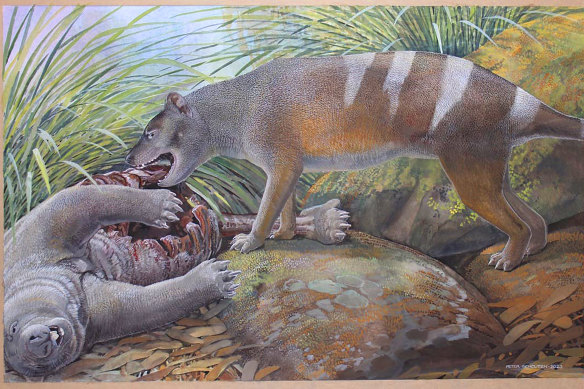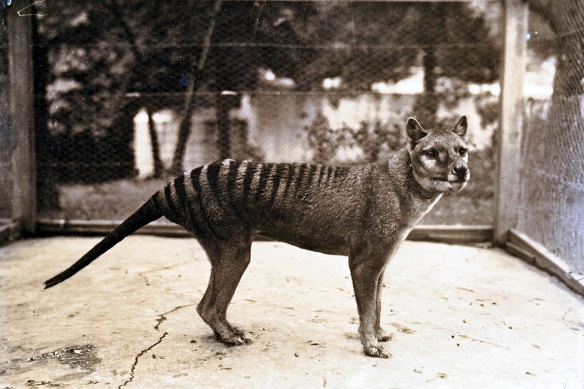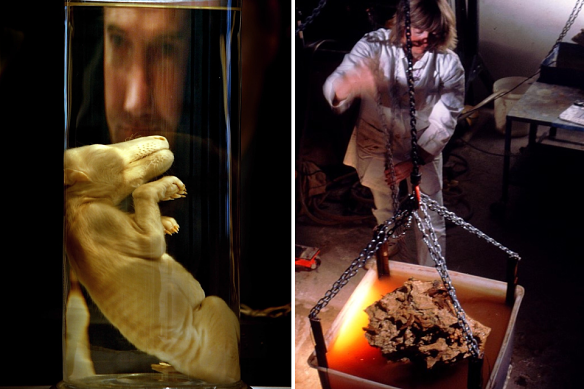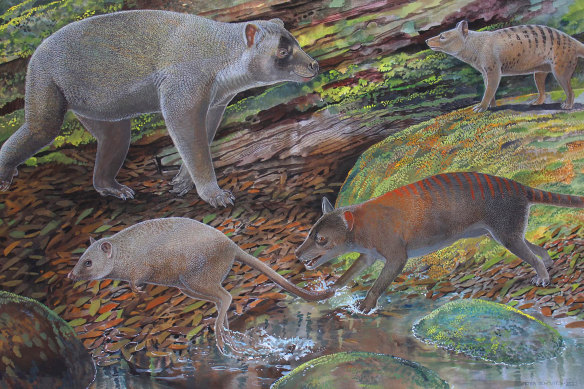- Exclusive
- National
- Palaeontology
This was published 7 months ago
Scientists dissolved a boulder in acid – and a thylacine jumped out
By Angus Dalton
The discovery of bone-crushing fossilised jaws has led Sydney palaeontologists to uncover three new ancestors of the thylacine, or Tasmanian tiger, amid a contentious effort to resurrect the marsupial carnivore.
The research unveiling the thylacine’s oldest direct ancestor was published on Saturday, 88 years to the day since a striped, hunched, shivering thylacine who’d be mythologised as Benjamin – the last-known individual of the species – perished in the cold of a Hobart zoo.

Artist’s reconstruction of Badjcinus timfaulkneri, a newly discovered relative of the Tasmanian tiger, scavenging on the carcass of a prehistoric wombat.Credit: Peter Schouten
The new 23–25 million-year-old jawbones came from the Riversleigh fossil site on Waanyi country in north-western Queensland, where rocks bristle with thousands of bones preserved within an ancient limestone cave system.
In the lab at the University of NSW, researchers submerged boulders from the site in weak acetic acid – aka vinegar – and stripped away limestone layers over months until fossils emerged.
Lead author of the new research in the Journal of Vertebrate Paleontology, Timothy Churchill, had just begun his PhD when he received a message from the lab technician: “Oh, Tim, there’s a thylacine coming out of the rocks!”
Out came the big, thick jaws of what the researchers would call Badjcinus timfaulkneri. The prehistoric creature was about the size of a large Tasmanian devil and had worn-down teeth, suggesting it shared the devil’s penchant for munching on the bones and teeth of its prey.

The last thylacine, at Hobart Zoo in 1933. The creature, who has become popularly known as Benjamin but was actually female, died on September 7, 1936.Credit: David Fleay Trustees
Shortly after, from the fizz of another dissolving rock sprung a quoll-sized forest hunter, Nimbacinus peterbridgei, that appears to be the oldest direct ancestor of the Tasmanian tiger.
The third new species in the study was Ngamalacinus nigelmarveni, a fox-sized thylacine with “meat-cutting” notches in its teeth.
The research team includes Professor Mike Archer, who founded the first serious attempt to revive the tiger from the DNA of a pickled pup in 2000 when he was director of the Australian Museum.
“The thylacine was the last member of an incredibly rich family, and it was way out on the end of its evolutionary limb,” Archer said. “There were all different kinds, from tiny little chihuahua-sized guys all the way up to wolf-sized animals.

Left: Professor Mike Archer with the preserved pup that inspired his de-extinction program in 2000. Right: Dr Anna Gillespie recovering a thylacine fossil from a boulder using acetic acid.Credit: Reuters/UNSW
“If the early colonists had known that, I’d like to think they wouldn’t have been so quick to slaughter them, to the point where they suddenly were surprised that none were left.”
Ancient predators
It was once thought Australia’s ancient lands were dominated by reptilian predators, including Ice Age-era lizards the length of a minibus, anaconda-like snakes, terrestrial crocodiles that galloped after prey, and another dubbed the “drop croc” because it may have scaled trees like the modern-day goanna.
But these new fossils show that, at least in the Oligocene period 25 million years ago, thylacine predators ruled.

Artist’s reconstruction of thylacine ancestors Nimbacinus peterbridgei (top right) and Ngamalacinus nigelmarveni (bottom right). Also included are the unrelated animals, an Ilariid Kuterintja ngama (top left) and a macropod Gumardee springae (bottom left).Credit: Peter Schouten
“It’s quite sad, we’re uncovering how amazing the history of the thylacine was in the context of what ended up happening to it,” Churchill said. “We destroyed the thylacine very recently. And our ecosystems, especially in Tasmania, haven’t been the same. Our continent now is riddled with pests, cats, wild dogs.
“I think it’s really important to consider the possibility that bringing back the thylacine will actually help restore our native ecology.”
Archer’s thylacine resurrection effort ended in 2004. But he’ll be first in line to meet the revived thylacine, he said, should a new $15 million de-extinction attempt by the University of Melbourne and a US biotech company be successful.
“I’ve never given up on the idea that the thylacine is forever gone,” Archer said. “I don’t believe that extinction is forever.”
Examine, a free weekly newsletter covering science with a sceptical, evidence-based eye, is sent every Tuesday. You’re reading an excerpt – sign up to get the whole newsletter in your inbox.